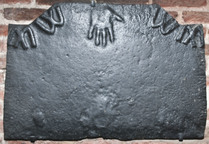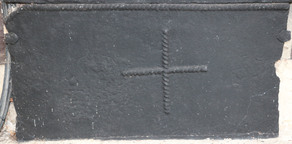-
1219
Description: Rectangular shape; twisted rope edging (top and sides); top centre, cross-shaped arrangement of four fleurs-de-lys between to crosses formed of lengths of twisted rope with single fleurs outside and beyond each of them a dagger, point upwards; to the right, a single fleur; bottom centre, a triangle formed of three lengths of twisted rope, vertex to the bottom, between two non-identical groups of three fleurs arranged in star pattern.
Notes: The style of the fleurs-de-lys associates this fireback with a series with several examples. The dagger type (approximate length 32cm) is different to others in the same series. Bishop & Miller Auctioneers, Stowmarket, 27 Jan 2022, lot 88 (£110).
- Decoration tags:
- rectangular (shape)
- rope (edging)
- simple stamps
- carved stamps
- heraldic
- apotropaic
- objects
Manufactured: in the mid- to late-16th century in the Weald area of England.
Current location: not known.
- Attached to series:
- Royal series
- Knife & Dagger stamp firebacks
- Fleur-de-lys firebacks
-
826
Description: Canted rectangular shape with moulded edging (top and sides) overlain by a length of twisted rope repeated six times; central vertical line formed of twisted rope, crossed with rope upper centre, with rope laid in a diamond pattern around the cross; lower centre, two irregular v-shapes formed of rope, one on each side of the vertical; shield shaped stamp with a fleur de lys repeated twice each side, upper left and right.
Notes: The twin V arrangement may have apotropaic significance and the cross above them having a Christian symbolism; the base board appears to have had a moulded edge, with rope lengths applied over part of the moulding after the board had been pressed into the casting bed; a sketch of this fireback was made by J. Starkie Gardner c.1891 and is in his collection at the Victoria and Albert Museum, Archive of Art and Design (AAD/2014/8).
- Decoration tags:
- rectangular with canted top corners (shape)
- rope over moulding (edging)
- simple stamps
- carved stamps
- heraldic
- apotropaic
- objects
Manufactured: in the late-16th century in the Weald area of England.
Current location: in private hands, Burwash, East Sussex, England.
- Attached to series:
- Miscellaneous stamp firebacks
- Rope design firebacks
- Fleur-de-lys firebacks
-
247
Description: A modified recasting of a variant of the ‘Armada’ fireback, with initials changed to IK, a single anchor panel, and the addition of a plain base and borders, the latter each with a twisted rope saltire, upper middle.
Notes: It is likely that an original four-panel fireback has been used to recast a copy with additional side and base panels; the saltires may have apotropaic significance. A second fireback at the house cast in the 19th century is identical but for being 1% smaller all round, and has a full-width extension on top bearing four symmetrical rope saltires, the outer two larger than the inner two. The first example was used to make the second.
Inscription: 1588 / IK
- Decoration tags:
- rectangular with round arch (shape)
- simulated rope (edging)
- simple stamps
- carved pattern panels
- composite
- extension panels
- apotropaic
- text
- plants
- objects
Manufactured: in the 17th century in the Weald area of England.
Current location: Chawton House, Chawton, Hampshire, England.
- Attached to series:
- Armada series
-
1148
Description: A composite recasting placing, on a plain background with symmetrical rope saltires, a recast variant of the ‘Armada’ fireback, with changed initials, a single anchor panel, and the addition of plain base and borders, the latter each with a twisted rope saltire, upper middle.
Notes: It is likely that an original four-panel fireback was used to cast an early copy with additional side and base panels. In the 19th century this second fireback was used to cast this third fireback with an additional full-width extension on top bearing four symmetrical rope saltires, the outer two larger than the inner two. The image of this fireback has been reconstructed by computer, combining photographs of the two fragments into which it had been broken.
Inscription: 1588 / IK
- Decoration tags:
- rectangular (shape)
- none (edging)
- simple stamps
- carved pattern panels
- composite
- apotropaic
- text
- plants
- objects
Manufactured: in the early- to mid-19th century in England.
Current location: Chawton House, Chawton, Hampshire, England.
- Attached to series:
- Armada series
- Composite firebacks
-
1196
Description: Quasi-rectangular shape; twisted rope edging (top and sides); 'W' in top corners, between which are a line of five stamps: a 'renaissance' style shield bearing a rose and crown, between two rose stamps, and a rectangular stamp bearing a griffin at each end; below each dragon stamp, a 'W' preceded by a reversed 'P'; below this, the line of five stamps repeated.
Notes: The shield and griffin stamps have been seen on other firebacks, associating them with a common producer; the 'W' may be apotropaic and symbolic of the Virgin Mary. Illustration from Christy 1908 who noted the fireback at Guildford, Surrey.
Inscription: W W / qW qW
- Decoration tags:
- rectangular (shape)
- rope (edging)
- simple stamps
- carved stamps
- individual letters
- heraldic
- apotropaic
- animals
Manufactured: in the mid- to late-16th century in the Weald area of England.
Current location: not known.
- Attached to series:
- Griffin series
-
1194
Description: Rectangular shape; twisted rope or strap edging (top and sides); semi-random arrangement of three stamps interspersed with rope crosses and rope 'squares' with saltires or linked smaller squares within; low centre, a crowned rose-en-soleil stamp repeated, more or less regularly, five times across the width of the fireback; above, four circular butter mould stamps with a hexagonal design, between which are two rope squares with saltires and, to the left, a rope square containing a smaller square with its corners linked to the corners of the outer square; above, a horned sheep standing on a base repeated four times, between which are two crowned rose-en-soleil stamps and four rope crosses, with a square-within-a-square at the right end.
Notes: The rose-en-soleil was the badge of King Edward IV and, thus, a Yorkist symbol. It, together with the butter mould and rope squares, are seen on other firebacks associating them with the same producer/foundry. A ram is the crest of the Gage family of West Firle, for many centuries major landholders in Sussex; it is also the crest of the Clothworkers' Company of London. Formerly at Heringdales/Heronsdale Manor, Waldron, East Sussex, which, however, was not a Gage property. Illustration from Christy 1908.
- Decoration tags:
- rectangular (shape)
- rope (edging)
- simple stamps
- carved stamps
- heraldic
- apotropaic
- animals
- objects
Manufactured: in the mid- to late-16th century possibly at Pounsley Furnace, Framfield in the Weald area of England.
Current location: Wickham Manor, Winchelsea, East Sussex, England.
Museum number: NT/WMF/M/007 (part of the National Trust museum group)
Citation: Gardner, J. S., 1898, 'Iron Casting in the Weald', Archaeologia, 56, 1, pp. 133-164.
- Attached to series:
- Pounsley series
- Food mould stamp firebacks
- Rose-en-soleil series
-
1195
Description: Rectangular shape; no edging; top centre, cross formed of two lengths of twisted rope, with a flattened saltire of the same below; top right, a shield, indented at the top, charged with a bird upon a branch, below which is an indeterminate semi-spherical feature; on each side of the cross, a stylised fleur-de-lys in low relief; top left, an inverted shield with indeterminate decoration (suggested by Christy to be IC).
Notes: The cross and saltire will have had an apotropaic purpose. Illustration from Christy 1908, who stated it was in Buxted, East Sussex.
- Decoration tags:
- rectangular (shape)
- none (edging)
- simple stamps
- carved stamps
- heraldic
- apotropaic
- objects
Manufactured: in the early- to mid-16th century in the Weald area of England.
Current location: not known.
- Attached to series:
- Bird shield series
- Rope design firebacks
-
39
Description: Quasi-arched rectangular shaped with cavetto canted top corners; fillet edging; two V-shaped arrangements of laths, one inverted and superimposed over the other, in centre of plate; date split on either side; initials in triangular arrangement above laths.
Notes: The shape of the fireback is very similar to firebacks at Knole, Sevenoaks, of similar date, and may be the product of the same furnace; the 'X' shapes may have apotropaic significance.
Inscription: 17 RSL 28
- Decoration tags:
- rectangular with canted top corners and round arch (shape)
- fillet (edging)
- simple stamps
- individual letters
- individual numbers
- apotropaic
- text
- objects
Manufactured: in 1728 in the Weald area of England.
Current location: Cranbrook Museum, Cranbrook, Kent, England.
- Attached to series:
- 1720s Wealden series
- Miscellaneous stamp firebacks
-
1113
Description: Quasi-rectangular with a three-facetted arch; top centre, left hand print; around each shoulder, M W mirrored.
Notes: The likelihood is that the M and W are formed of a double-V (virgo virginum) intended to symbolise the Virgin Mary and have an apotropaic (evil-averting) purpose. It may be of significance that hand prints seen on firebacks are always of the left hand.
Inscription: MW WM
- Decoration tags:
- rectangular with triple-facetted arch (shape)
- none (edging)
- simple stamps
- individual letters
- apotropaic
- text
- humans
Manufactured: in the early-17th century possibly in the Weald area of England.
Current location: in private hands, Crowborough, East Sussex, England.
- Attached to series:
- Hand print firebacks
-
1115
Description: Fragment; canted rectangular; twisted rope edging (topand sides); central cross of twisted rope.
Notes: Sections missing at both ends.
- Decoration tags:
- rectangular with canted top corners (shape)
- rope (edging)
- simple stamps
- apotropaic
- objects
Manufactured: in the 16th century in the Weald area of England.
Current location: in private hands, Crowborough, East Sussex, England.
- Attached to series:
- Rope design firebacks









